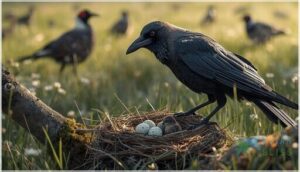This site is supported by our readers. We may earn a commission, at no cost to you, if you purchase through links.
Ravens thrive on a menu that would make most specialists envious—from fresh carrion on mountain highways to berries in alpine meadows, and even the occasional backyard raid. These jet-black opportunists don’t just eat what’s available; they actively hunt, strategize, and cache food with striking intelligence.
Their ability to shift between protein-heavy winter scavenging and summer’s plant-based bounty demonstrates an adaptability that’s helped them colonize nearly every habitat in the Northern Hemisphere. Understanding what ravens eat reveals not just their survival skills, but how deeply intertwined their lives have become with both wild ecosystems and human landscapes.
Table Of Contents
- Key Takeaways
- What Do Ravens Eat?
- Animal-Based Foods in The Raven Diet
- Plant-Based Foods Ravens Consume
- Insects and Invertebrates as Food Sources
- Scavenging and Opportunistic Feeding
- Seasonal Changes in Raven Diet
- Regional Variations in Raven Feeding
- Raven Foraging Techniques and Strategies
- Nutritional Needs and Caloric Intake
- Human Influence on Raven Diet
- Frequently Asked Questions (FAQs)
- Conclusion
Key Takeaways
- Ravens eat a wide variety of foods, including carrion, small mammals, insects, berries, nuts, seeds, and human garbage, adapting their diet to what’s available in each season and habitat.
- Their intelligence allows them to hunt, cache food, use tools, and exploit both wild and human-influenced environments for survival.
- Seasonal changes drive ravens to shift between protein-rich animal foods in winter and plant-based options like fruits and seeds in warmer months, with frequent food caching in autumn.
- Human activity, especially landfills and agriculture, has boosted raven populations and altered local ecosystems by increasing access to food and intensifying predation on sensitive wildlife.
What Do Ravens Eat?
Ravens eat a wide range of foods, and their choices might surprise you. These birds don’t stick to just one type of meal—they’re true opportunists.
Here’s a closer look at what makes up their everyday menu.
Overview of Raven Diet
When you look at the Common Raven’s menu, you’ll find one of nature’s best examples of a dietary opportunist. Ravens are true omnivores and scavengers, sampling everything from mammal carrion and live prey to berries and garbage. Food proportions shift across regions, and there’s noticeable inter-individual variation.
This dietary flexibility, shaped by habitat influence, keeps raven feeding habits remarkably adaptable. Ravens also exhibit complex behaviors, such as caching food to hide it.
Omnivorous Feeding Habits
You won’t find many birds with such dietary adaptations as ravens. Being omnivores and expert scavengers means they thrive on variety—one day snacking on berries, the next tearing into animal remains or digging for beetles.
Their feeding behavior showcases striking food versatility. This makes foraging efficient, provides varied nutrition, and lets ravens exploit almost every available food source in their environment.
This allows them to thrive by exploiting resource subsidies found near human developments.
Adaptability to Available Food
Raven feeding behavior is a masterclass in dietary plasticity. You’ll notice how their adaptability of raven diet lets them switch food sources based on season, habitat, or opportunity. For example, ravens:
- Shift from berries to roadkill in winter
- Exploit human subsidies near landfills
- Rely on food caching
- Adjust foraging strategies across biomes
That’s true biome flexibility.
Animal-Based Foods in The Raven Diet
Ravens rely heavily on animal-based foods to meet their nutritional needs. Their menu covers everything from fresh kills to smaller prey and even eggs.
Here’s a closer look at the main sources they depend on.
Carrion and Roadkill
Ever wondered who’s cleaning up animal carcasses along roads and fields? You’re seeing nutrient cycling in action.
Ravens excel at Roadkill Removal, outcompeting other scavengers, especially in modified habitats. Their reliance on carrion and roadkill spikes in winter and autumn, as natural food wanes.
This seasonal reliance shapes their role in scavenger competition and ecosystem balance.
Small Mammals and Rodents
A keen-eyed raven won’t pass up a plump vole or mouse. Small mammals and rodents serve as a Winter Diet Staple, offering high Mammal Nutritional Value when food is scarce. You’ll notice ravens:
- Hunt live prey, especially during Rodent Predation Rate peaks.
- Forage in fields, aiding Agricultural Pest Control.
- Shape Ecosystem Impact by regulating rodent populations.
Birds, Eggs, and Nestlings
Nest predation rates spike when ravens target bird eggs, nestlings, and fledglings, especially in spring. You’ll see them using sharp predation techniques—scanning for ground-nesting species, caching eggs, and returning for more.
Their prey includes sage-grouse and plovers, with ecological impacts that ripple through bird populations. Seasonal influences drive ravens to focus on birds and eggs, shaping local species stability.
Reptiles and Amphibians
When you look at ravens in arid landscapes, their diet often shifts toward reptiles and amphibians, thanks to habitat variation and seasonal trends. Tortoise predation is a real concern, and amphibian consumption rises during wet spells. You’ll find ravens targeting specific species, such as:
- Juvenile desert tortoises and whiptail lizards
- Western toads and green frogs
- Fire salamanders
Plant-Based Foods Ravens Consume
Ravens don’t just rely on meat; they also eat a surprising variety of plant foods. Their choices shift with the seasons and what’s available in their habitat.
Here are some of the plant-based options that make up part of a raven’s diet.
Fruits and Berries
When fruit is ripe and the berries are colorful, ravens turn into expert foragers, weaving through orchards and woodlands in search of the best bites. You’ll find them raiding crops, caching surplus berries, and feasting on plant matter.
These seasonal treats aren’t just for show—they deliver water, quick calories, and key nutritional benefits, with fruit toxicity rarely slowing a raven down.
Nuts and Seeds
Ever watched a raven crack a walnut with pure determination? You’re witnessing nature’s solve-it-quick artist. From peanuts to acorns, ravens treat nuts and seeds as winter treasure, stashing thousands for lean months. Their Seed Nutritional Value is essential—delivering energy when prey is scarce—while clever Foraging Techniques and Caching Behavior set them apart from other corvids.
- Nuts offer dense calories for harsh seasons.
- Ravens use specific Foraging Techniques (e.g., dropping nuts on rocks).
- Seasonal Consumption and memory aid their caching success.
Grains and Agricultural Crops
Ravens have a knack for exploiting fields of wheat, barley, and oats—especially during planting and seedling stages. Crop depredation isn’t just minor mischief; when seeds and tiny shoots disappear, fields suffer economic impact, forcing expensive replanting.
Regional variations shape strategies: some farmers increase planting depth or use scare devices, balancing the birds’ resourcefulness against practical management.
Insects and Invertebrates as Food Sources
Ravens don’t just rely on big meals; they often hunt for small creatures too. Insects and invertebrates are a key part of their everyday menu.
Here’s a closer look at what kinds they tend to find and eat.
Beetles, Grasshoppers, and Caterpillars
When you think about what keeps a raven thriving, insects stand out as a surprisingly important staple. Through summer and fall, beetle biomass can make up a large portion of the diet, especially as insect seasonality peaks. Grasshopper consumption often surges in lush, rainy years, while caterpillar predation jumps dramatically during spring outbreaks.
All this insect eating does more than fill bellies—it helps control pest populations and shapes the ecological impact of ravens across diverse landscapes.
Earthworms and Other Invertebrates
Beyond the buzz and crunch of beetles, you’ll find ravens eagerly probing wet soil for earthworms and snails—especially after rain, when earthworm prevalence spikes by over 50%. Their invertebrate diet is diverse and impressive:
- Slugs and gastropods in coastal zones
- Spiders and ants in grasslands
- Aquatic larvae near streams
The nutritional value of these invertebrates is high—earthworms, for instance, pack 60–70% protein and essential fats. Seasonal shifts and moisture levels drive the ravens’ foraging techniques: they flip rocks, probe dirt, and dig through leaf litter to uncover these protein-rich morsels.
Scavenging and Opportunistic Feeding
Ravens are master opportunists, and scavenging is at the heart of their survival strategy. Rather than hunting every meal, they’ve learned to let others do the hard work and simply follow the action.
You’ll find them shadowing predators, raiding trash bins, and exploiting every food opportunity across both urban and rural landscapes.
Following Predators for Leftovers
When large predators like wolves and cougars make a kill, you’ll often spot ravens arriving within minutes, using behavioral cues and visual detection to find fresh animal carcasses. These intelligent scavengers wait nearby, watching for predator departure before descending in groups.
Ravens can remove up to 75% of edible biomass from smaller kills, making them highly effective competitors in the scavenging hierarchy through coordinated foraging strategies.
Feeding on Garbage and Human Food Waste
You’ll find ravens thriving around human settlements, where landfills and urban dumpsters provide steady food supplies. Research shows that ravens nesting near garbage sites have pellets dominated by trash and processed foods.
In Alaska’s oil fields, dumpsters serve as reliable feeding stations even in harsh winter conditions. This dependence on refuse has boosted raven populations considerably, creating measurable ecological consequences for sensitive prey species nearby.
Urban and Rural Scavenging Behavior
When ravens scavenge in urban areas, they target parklands and concentrate foraging between 7 am and 11 am, when 53% of carcass removals occur. Rural scavenging peaks at dawn and dusk instead.
Resource selection varies dramatically—urban ravens exploit dumpsters and roadkill, while rural populations follow predators to fresh kills.
Seasonal patterns shift scavenger interaction too, with spring bringing the highest foraging intensity as young birds begin opportunistic feeding independently.
Seasonal Changes in Raven Diet
Ravens don’t eat the same foods year-round—they shift their diet as the seasons change and certain resources become available or scarce. From the protein-packed meals of spring to the lean pickings of winter, these birds adjust their foraging strategies to match what nature offers.
Here’s how their diet changes through the year.
Spring and Summer Food Sources
Spring and summer transform raven foraging behavior as the landscape bursts with life. You’ll notice ravens shift to an insect-heavy diet during these warmer months, capitalizing on abundant prey. Their springtime menu expands dramatically:
- Insects like grasshoppers and beetles comprise up to 62% of their diet during peak breeding season
- Nest predation on eggs and nestlings increases, with 28% of nest contents showing bird remains
- Fruits and seeds from prickly pear, hackberry, and agricultural crops contribute 17% of their intake
Carrion scavenging continues, but opportunistic feeding on human food waste intensifies near developed areas.
Autumn Harvest and Caching
As autumn arrives, you’ll see ravens dramatically increase their caching behavior—storing food up to 500 times more frequently than summer. They hide carrion, insects, grains, and berries in sheltered spots like rock crevices and thickets.
This survival strategy directly impacts their overwinter fitness, with frequent cachers maintaining higher body weights and showing 70% cache retrieval success rates among adults.
Winter Reliance on Carrion and Caches
When temperatures plummet, you’ll notice ravens shift their foraging patterns dramatically—carrion may account for up to 50% of their winter diet. Their survival hinges on three strategies:
- Scavenging fresh carcasses: Wolf kills and hunter-left gut piles provide 60% of needed calories
- Cache site defense: Individual ravens guard stored meat for days
- Carrion energetics: Fat-rich scraps fuel thermoregulation in sub-freezing conditions
This winter diet shift directly influences raven population dynamics in harsh climates.
Regional Variations in Raven Feeding
Where a raven lives shapes what ends up on its plate. Arctic birds face a vastly different menu than their desert cousins, and coastal populations have food options that inland ravens can only dream about.
Let’s look at how ravens adapt their diets across three distinct environments.
Arctic and Tundra Diets
In Arctic tundra, ravens walk a tightrope between predator and scavenger. Studies on Alaska’s North Slope reveal they draw 50% of their winter energy from hunting small mammals like voles and 50% from scavenging caribou and ptarmigan carcasses. They also follow polar bears to seal kills and flock to human dumps, showing how climate change and human impact reshape tundra food webs and scavenging strategies year-round.
| Food Source | Season | % of Diet |
|---|---|---|
| Microtine rodents (voles) | Winter | ~25% (predation) |
| Caribou/ptarmigan carrion | Winter | ~25% (scavenged) |
| Polar bear seal remains | Year-round | Variable |
| Human waste at dumps | Year-round | Increasing |
| Marine-derived carcasses | Coastal/winter | Supplemental |
Desert and Arid Region Adaptations
In deserts, ravens face scorching heat and scarce water—yet they thrive. Their diet shifts dramatically: animal-based food sources reach 62% in the Mojave, with reptiles, roadkill carrion, and insects dominating.
Desert foraging relies on water-rich prey like eggs, while cactus fruits boost arid water intake.
Anthropogenic influence near landfills drives populations 16 times higher, intensifying ecological impact on seasonal resources and native species like desert tortoises.
Coastal and Riverine Food Sources
When your journey hugs the coast or trails a river, you’ll spot ravens putting their clever foraging techniques to work. Coastal birds hunt aquatic prey like fish and shellfish, supplementing with marine plants when pickings run thin.
Their scavenging habits stand out—snatching marine life, roadkill, or anything edible washed ashore—highlighting striking diet variations along these active coastlines and waterways.
Raven Foraging Techniques and Strategies
Ravens don’t just stumble onto their next meal—they hunt for it with purpose and skill. These birds use a combination of visual scanning, physical manipulation, and clever problem-solving to access food that other scavengers might miss.
Here’s how ravens put their intelligence and adaptability to work when foraging.
Perching and Scanning for Food
When you watch ravens hunt, you’ll notice they start by choosing a good vantage point. Perch height generally ranges from 2.5 to 10 meters, giving them a clear view of potential raven food sources below.
Their scanning patterns are impressively thorough:
- Ravens turn their heads 3–4 times per minute during active vigilance behavior
- They can inspect a 270-degree field simultaneously while perched
- Foraging techniques include 44–61% of time spent watching before moving
This decision-making process, refined through social context with other ravens, helps them detect food with 81% accuracy. Their raven feeding behavior balances finding meals with watching for threats—about 57% of perching time focuses on predator vigilance.
Probing, Digging, and Flipping Objects
You’ll find ravens don’t just scan from above—they actively disturb their surroundings to uncover hidden meals. Object manipulation happens about 2.5 times per hour, with juveniles leading this foraging behavior.
When ravens flip stones or probe soil, they retrieve insects 68% of the time. This substrate disturbance accounts for half of all winter feeding strategies, boosting prey extraction success by 31%.
Tool Use and Problem-solving
Beyond physical manipulation, ravens demonstrate tool use and cognitive abilities that rival great apes. You’ll see them select sticks or stones to access food, achieving 90% success after training.
Their cognitive planning allows them to choose correct tools for future tasks, outperforming four-year-olds in planning tests. This intelligence, combined with memory retention and social learning, makes creative strategies possible even for tool-naive individuals.
Nutritional Needs and Caloric Intake
Ravens need a surprising amount of fuel to power their active lifestyle and sharp minds. Their daily energy requirements depend on body size, seasonal demands, and whether they’re raising young.
Protein-rich carrion forms the backbone of their nutrition, but the specific needs shift throughout the year and across different life stages.
Daily Energy Requirements
Your raven’s daily energy budget depends on what’s happening in its world. These intelligent birds burn through roughly 3,000 kilojoules per day, but several factors shift that baseline:
- Climate impact – Cold winters demand extra calories for thermogenesis
- Body mass – Larger ravens need more fuel, especially at higher latitudes
- Foraging energy – Active flight and hunting spike metabolic rate
- Homeostasis – Maintaining internal balance requires continuous energy
Protein and Fat Sources
Animal protein and dietary fat fuel your raven’s impressive brain and flight muscles. Meat from carrion provides over 50% of their assimilated diet, delivering concentrated protein and fat. Insects like grasshoppers—sometimes 750 per day—add summer protein.
Seasonal intake shifts dramatically: pinyon pine nuts and fatty animal tissue dominate winter months, while eggs and seed nutrition from agricultural crops supplement spring and autumn diets. Human sources increasingly fill nutritional gaps in urban populations.
Feeding Young and Regurgitated Food
When raising nestlings, parent ravens regurgitate partially digested food 4–6 times per hour during the first two weeks. This regurgitation technique fosters rapid chick development—baby ravens reach 1.2 kg at fledging after intensive parental investment spanning four important weeks in the nest.
Both adults make up to 52 feeding trips daily, delivering protein-rich meals straight into gaping mouths.
Human Influence on Raven Diet
Humans have dramatically reshaped what ravens eat and where they find their meals. From sprawling landfills to roadside carcasses and backyard bird feeders, we’ve created new food landscapes that ravens have eagerly exploited.
Let’s look at how our activities influence their diet, the temptation to feed them directly, and what happens when ravens start relying too heavily on human-provided resources.
Impact of Agriculture and Landfills
Human-derived food has reshaped where and how ravens live. Landfills create year-round buffets, boosting local populations by reducing winter mortality and increasing reproductive success. You’ll notice three major shifts:
- Landfill Abundance – Ravens within 15 km of dumps show considerably higher numbers
- Agricultural Shifts – Over 70% of raven damage impacts farms, with birds targeting livestock feed and crops
- Ecosystem Effects – Subsidized populations increase predation on ground-nesting birds, sometimes devastating threatened species like sage-grouse
Feeding and Attracting Ravens
Want to bring ravens to your yard? Unsalted peanuts and meat scraps work best as attractant food types. Place them on large platform feeders or directly on the ground—ravens prefer open feeding spaces. Stick to a consistent schedule; these birds quickly memorize reliable food sources.
Just remember: cat food and other high-appeal options also draw raccoons and other non-target species you mightn’t want visiting.
Risks of Habituation and Dependence
When you regularly feed ravens, you’re not doing them favors. Habituated birds show 60% less fear of humans and up to 35% more aggressive exploration—behavioral changes that increase disease transmission risks at shared feeding sites.
Regularly feeding ravens makes them dangerously fearless around humans and more aggressive, increasing disease risks at shared feeding sites
Population imbalances follow: raven numbers can double near subsidies, boosting predation on sensitive ground-nesting birds by over 40%. Conservation impacts ripple outward from seemingly harmless backyard interactions.
Frequently Asked Questions (FAQs)
What do ravens eat?
Ravens thrive on an omnivorous diet, showing considerable Dietary Adaptations and Foraging Behavior. They’ll eat everything from carrion and insects to grains, berries, and discarded human food, with Raven feeding habits shifting thanks to Seasonal Variation and Regional Differences.
Do ravens eat Crows?
Direct predation on healthy crows is rare, but scavenging crows or raiding nests for eggs and nestlings does occur.
This highlights dietary overlap, cannibalistic behavior, and the intricate relationship of raven predators, crow defense, and bird species survival.
Are Ravens omnivores?
Like nature’s greatest generalists, these intelligent corvids are definitively omnivorous. Dietary confirmation through stable isotope analysis reveals ravens consume multiple trophic levels—animal proportions averaging 50-70% alongside significant plant consumption, with human subsidies increasingly shaping raven diet composition.
Do ravens eat carrion?
Yes, carrion is a cornerstone of the raven diet. These skilled scavengers locate animal carcasses quickly, often arriving at predator kills within minutes.
Roadkill also provides reliable nutrition, especially near highways and human developments.
What does a raven scavenger eat?
As scavengers, these birds feast on carrion from carcasses, roadkill hotspots, and garbage. They’ll strip corpse biomass efficiently, facing carrion competition from wolves and other scavengers.
Urban scavenging and seasonal scavenging patterns shift their food sources throughout the year.
How do Ravens feed their chicks?
Adult birds feed their nestlings through regurgitation, delivering partially digested meat and insects directly into chicks’ mouths.
Both parents share parental roles, visiting the nest multiple times hourly to meet the intense energy demands of rapid growth.
What is the Ravens’ favorite food?
Ravens show clear raven food preferences for protein-rich options. Their preferred carrion tops the list, followed by nestling preference for eggs and chicks.
Urban food sources, insect protein, and fruit selection round out their raven feeding habits.
How do you attract Ravens to your yard?
To attract ravens, offer food provisioning like eggs or unsalted peanuts on a large, open platform, maintain fresh water sources, provide perches, and feed on a consistent routine.
Consider ethical concerns to avoid habituation or over-dependence on human food.
Are ravens aggressive?
Just when you think peace reigns among these dark-winged birds, intraspecific aggression and fierce territorial defense can flare up.
Still, aggression modulation keeps most raven interactions with humans low, especially outside nesting season or food competition.
What do you feed, crows or ravens?
If you’re feeding crows or ravens, offer safe foods like unsalted nuts, berries, eggs, and small meat scraps. Pet food works in moderation.
Remember, ethical feeding means avoiding processed or spoiled foods and minimizing human dependence.
Conclusion
Picture a raven perched on a snowy fencepost, scanning for scraps—a living metaphor for adaptability. What do ravens eat? Nearly anything their sharp minds and keen eyes can find.
From animal remains to wild berries and discarded human food, their diet is a clear indication of survival in changing landscapes. Understanding this feeding behavior gives you insight into how ravens thrive alongside us, reminding you that resilience often means knowing how to make the most of what’s available.
- https://birdfact.com/articles/what-do-ravens-eat
- https://bioone.org/journals/wildlife-biology/volume-11/issue-2/0909-6396_2005_11_101_EORCCS_2.0.CO_2/Effect-of-raven-Corvus-corax-scavenging-on-the-kill-rates/10.2981/0909-6396(2005)11%5B101:EORCCS%5D2.0.CO;2.full
- https://academic.oup.com/condor/article-abstract/91/2/372/5189159
- https://digitalcommons.humboldt.edu/cgi/viewcontent.cgi?article=1854&context=etd
- https://www.scientificamerican.com/article/young-ravens-rival-adult-chimps-in-a-big-test-of-general-intelligence/
















